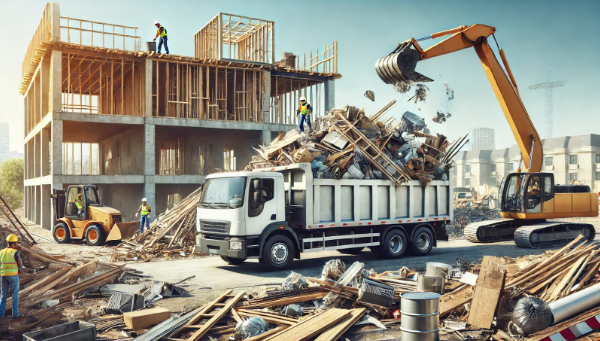
The Ultimate Guide to Construction Debris Removal: Efficient, Eco-Friendly Solutions
If you've ever been involved in a construction project, you know how quickly debris can pile up. Whether it’s drywall, lumber, concrete, or packaging materials, managing construction waste can be a headache. But clearing out construction debris doesn’t have to be overwhelming. With the right strategies, you can keep your site safe, clean, and compliant with local regulations. In this guide, we’ll dive into everything you need to know about efficient and eco-friendly construction debris removal.
Why Proper Construction Debris Removal Is Important
1. Ensures Site Safety
A clean job site is a safe job site. Piles of debris can create trip hazards, obstruct pathways, and increase the risk of accidents. Regular debris removal helps keep your team safe and your project running smoothly.
2. Compliance with Local Regulations
Many cities have strict guidelines on how construction waste should be disposed of. Failing to comply can lead to hefty fines and delays. Proper debris removal ensures you stay compliant and avoid penalties.
3. Eco-Friendly Practices
Construction projects generate a significant amount of waste. By recycling and repurposing materials, you can reduce landfill waste and promote sustainability in your construction projects.
4. Boosts Efficiency
A clutter-free site improves efficiency, allowing workers to move freely and complete tasks more quickly. Removing debris as you go helps keep your project on schedule.
Types of Construction Debris and How to Handle Them
| Debris Type | Examples | Disposal Options |
|---|---|---|
| Concrete and Asphalt | Concrete slabs, broken asphalt | Recycling centers for aggregate |
| Wood and Lumber | Pallets, scrap wood, framing | Wood recycling, donation |
| Metals | Steel, copper, aluminum | Scrap metal yards |
| Drywall and Plaster | Old drywall, plaster debris | Specialized recycling facilities |
| Plastics and Packaging | Shrink wrap, plastic sheeting | Curbside recycling, drop-offs |
| Hazardous Waste | Paint, chemicals, solvents | Hazardous waste facilities |
Step-by-Step Guide to Efficient Construction Debris Removal
Step 1: Conduct a Site Assessment
Before starting a project, assess the site to estimate the type and volume of debris you’ll generate. This will help you plan for disposal and recycling.
- Create a waste management plan: Outline how you’ll handle different types of debris, including recycling and disposal.
- Identify hazardous materials: Separate items like paints, chemicals, and asbestos for special handling.
Step 2: Sort and Separate Debris
Organizing your debris on-site can save time and reduce disposal costs.
- Set up designated bins for recyclables, donations, and trash.
- Sort materials by type: Wood, metal, and concrete should be separated to maximize recycling potential.
- Label bins clearly to avoid confusion and ensure proper disposal.
Step 3: Choose the Right Disposal Method
Decide whether to handle debris removal in-house or hire a professional service.
- Dumpster rental: Ideal for ongoing projects with consistent waste generation.
- Professional junk removal services: Perfect for one-time cleanouts or when handling bulky or hazardous items.
- Recycling services: For items like metal, wood, and concrete, partner with local recycling centers.
Step 4: Recycle and Repurpose When Possible
Instead of sending everything to the landfill, consider recycling or repurposing materials.
- Concrete: Can be crushed and used as aggregate for new construction projects.
- Wood: Untreated wood can be repurposed for landscaping or donated to local non-profits.
- Metal: Metals like steel and copper can be sold to scrap yards for cash.
Tips for Minimizing Construction Debris
- Plan Ahead
- Create a waste management plan before starting your project to identify recycling and disposal options.
- Reuse Materials
- Save money and reduce waste by reusing items like wood, bricks, and metal whenever possible.
- Rent Reusable Containers
- Use reusable bins and containers to collect debris, reducing the need for single-use plastic bags.
- Partner with Local Charities
- Donate leftover materials like wood, fixtures, or furniture to local non-profits.
FAQs on Construction Debris Removal
Q1: How much does construction debris removal cost?
The cost varies based on the volume of debris, type of materials, and whether you rent a dumpster or hire a service. On average, a full truckload can range from $300 to $1,000.
Q2: Can all construction debris be recycled?
Not all debris can be recycled. While items like concrete, metal, and wood can be repurposed, hazardous materials require special disposal.
Q3: Do I need a permit to rent a dumpster?
In many cities, you may need a permit if the dumpster is placed on a public street. Check with your local municipality for regulations.
Q4: How often should I schedule debris removal?
For ongoing projects, schedule regular pickups to prevent debris from piling up. For one-time projects, arrange for removal at the end.
Quick & Reliable
We are available by phone or email
Cities we service
Services
All Rights Reserved | MetroWest Disposal Powered by Junk Removal Money
